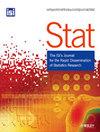利用局部线性近似在图形模型中进行最大后验估计
IF 0.8
4区 数学
Q3 STATISTICS & PROBABILITY
引用次数: 0
摘要
高维高斯图形模型中的稀疏结构学习是多元统计推断中的一个重要问题,因为稀疏模式自然地编码了变量之间的条件独立性关系。然而,在分层先验模型下,最大后验(MAP)估计具有挑战性,传统的数值优化程序或期望最大化算法难以实现。为此,我们提出了一种新颖的局部线性近似方案,利用非常简单的计算算法规避了这一问题。最重要的是,我们明确提出了保证算法收敛到 MAP 估计值的条件,并证明该条件涵盖了包括图形马蹄在内的一大类完全单调先验。此外,还证明了所得到的 MAP 估计值是稀疏的,并且在-正态下是一致的。数值结果验证了所提方法的速度、可扩展性和统计性能。本文章由计算机程序翻译,如有差异,请以英文原文为准。
Maximum a posteriori estimation in graphical models using local linear approximation
Sparse structure learning in high‐dimensional Gaussian graphical models is an important problem in multivariate statistical inference, since the sparsity pattern naturally encodes the conditional independence relationship among variables. However, maximum a posteriori (MAP) estimation is challenging under hierarchical prior models, and traditional numerical optimization routines or expectation–maximization algorithms are difficult to implement. To this end, our contribution is a novel local linear approximation scheme that circumvents this issue using a very simple computational algorithm. Most importantly, the condition under which our algorithm is guaranteed to converge to the MAP estimate is explicitly stated and is shown to cover a broad class of completely monotone priors, including the graphical horseshoe. Further, the resulting MAP estimate is shown to be sparse and consistent in the ‐norm. Numerical results validate the speed, scalability and statistical performance of the proposed method.
求助全文
通过发布文献求助,成功后即可免费获取论文全文。
去求助
来源期刊

Stat
Decision Sciences-Statistics, Probability and Uncertainty
CiteScore
1.10
自引率
0.00%
发文量
85
期刊介绍:
Stat is an innovative electronic journal for the rapid publication of novel and topical research results, publishing compact articles of the highest quality in all areas of statistical endeavour. Its purpose is to provide a means of rapid sharing of important new theoretical, methodological and applied research. Stat is a joint venture between the International Statistical Institute and Wiley-Blackwell.
Stat is characterised by:
• Speed - a high-quality review process that aims to reach a decision within 20 days of submission.
• Concision - a maximum article length of 10 pages of text, not including references.
• Supporting materials - inclusion of electronic supporting materials including graphs, video, software, data and images.
• Scope - addresses all areas of statistics and interdisciplinary areas.
Stat is a scientific journal for the international community of statisticians and researchers and practitioners in allied quantitative disciplines.
 求助内容:
求助内容: 应助结果提醒方式:
应助结果提醒方式:


